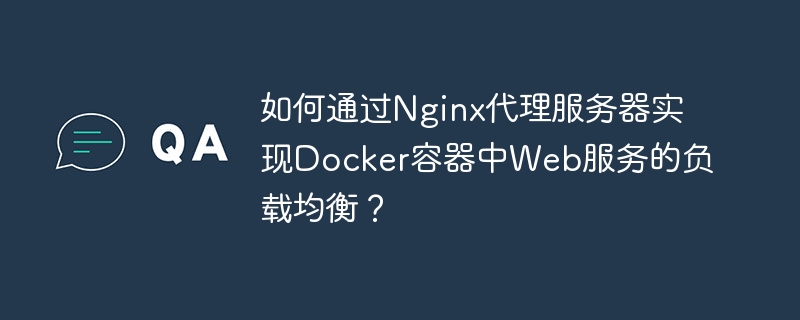Home >Backend Development >PHP Tutorial >How to implement load balancing of web services in Docker containers through Nginx proxy server?
How to implement load balancing of web services in Docker containers through Nginx proxy server?
- PHPzOriginal
- 2023-09-05 17:07:441550browse

How to implement load balancing of web services in Docker containers through Nginx proxy server?
In modern Internet applications, load balancing is an important consideration. It can help us achieve resource allocation and utilization among multiple servers and improve system availability and load capacity. Web services running in Docker containers can also be load balanced through the Nginx proxy server. This article will introduce how to implement load balancing of web services in Docker containers through Nginx proxy server.
First, we need to set up a Docker container environment to run our web service. In this example, we will use two containers to simulate a load balancing situation.
- Installing Docker
To run a Docker container, we need to install Docker first. Docker can be installed through the following commands:
sudo apt-get update sudo apt-get install docker.io
- Create two Web service containers
We can use Docker images to create Web service containers. Here we use a simple Nginx image as an example.
docker run -d -p 8081:80 --name=web1 nginx docker run -d -p 8082:80 --name=web2 nginx
The above command will create two containers, mapped to local ports 8081 and 8082 respectively, and named web1 and web2.
- Configure Nginx proxy server
In our load balancing solution, Nginx will act as a proxy server and forward client requests to the back-end Web service container. Let’s configure Nginx now.
First, install Nginx:
sudo apt-get install nginx
Then, edit the Nginx configuration file /etc/nginx/nginx.conf:
user nginx;
worker_processes auto;
http {
...
upstream backend {
server 127.0.0.1:8081;
server 127.0.0.1:8082;
}
...
server {
listen 80;
server_name example.com;
location / {
proxy_pass http://backend;
proxy_set_header Host $host;
proxy_set_header X-Real-IP $remote_addr;
}
}
...
}In the above configuration , we use the upstream directive to define two backend servers: 127.0.0.1:8081 and 127.0.0.1:8082. Then, in the server directive, we forward the request to the backend server using the proxy_pass directive and set some request headers through the proxy_set_header directive.
- Restart the Nginx service
After completing the Nginx configuration, you need to restart the Nginx service for the configuration to take effect.
sudo systemctl restart nginx
- Test load balancing
Now we can access the Nginx proxy server through the browser and observe the effect of load balancing.
Enter http://example.com in the browser, then refresh the page multiple times. You will find that requests will be forwarded evenly to the two web service containers in the backend.
So far, we have successfully implemented load balancing of Web services in Docker containers through the Nginx proxy server.
Summary:
Load balancing can help us realize resource allocation and utilization among multiple servers, and improve the availability and load capacity of the system. Through the Nginx proxy server, we can achieve load balancing of web services in Docker containers. The above are the steps and sample code for implementing load balancing through the Nginx proxy server. Hope this article helps you!
The above is the detailed content of How to implement load balancing of web services in Docker containers through Nginx proxy server?. For more information, please follow other related articles on the PHP Chinese website!

